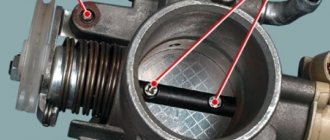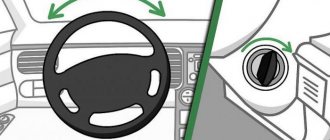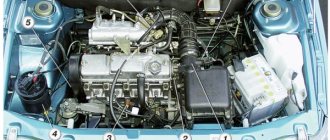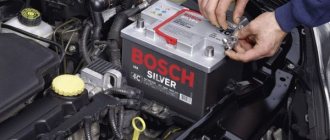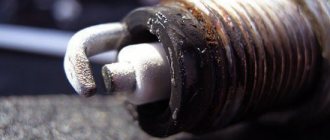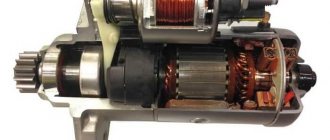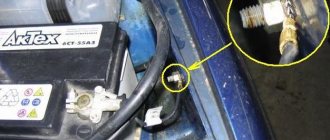Quite often, VAZ-2114 owners complain that the car stalls immediately when releasing the gas. In fact, almost all cars have this problem, including foreign cars.
The car's power plant starts up, and after the required speed is reached, the foot is removed from the gas drive. A serviceable vehicle continues to move, but one that has some specific defect immediately stalls.
And this happens despite the fact that when the ignition is turned on at idle, everything functions without any complaints.
How to find the cause of the problem
If the speed of the VAZ 2114 drops, you need to comprehensively diagnose the functioning of the injection system on your car, which can be done in your garage if you have a little experience and appropriate instructions. In this case, those “fourteeners” that were equipped from the factory with a dashboard from the German manufacturer VDO have an important advantage, since it, in comparison with the analogue from Schetmash, is equipped with a self-diagnosis mode.
To carry out this procedure, you will need to perform a few simple steps:
- After turning off the engine, you need to keep the odometer button pressed for three to five seconds;
- Having turned the engine ignition to the first position, the button must be released;
- arrows should appear on the display, which is a signal of normal operation, then the button must be pressed the first time (displaying the firmware version) and the second time - after this probable errors in the ECU will be shown;
- To reset the error message, you will need to hold the button until a zero appears on the display.
After reading the manual, you can find out what errors shown on the screen may be associated with the fact that the speed constantly drops when the gas is released on the VAZ 2114.
So, it could be one of the following situations:
- code 1 – controller error;
- code 14/15 – coolant sensor error;
- code 22/23 – throttle position sensor error;
- code 33/34 – mass air flow sensor error;
- code 42 – faulty ignition;
- code 44 – fuel mixture is lean or too rich.
The owner of a VAZ 2114 should remember a specific feature of the self-diagnosis mode on his car: if there are several errors, the computer sums their codes arithmetically, which can be misleading. This can be indicated by a logical discrepancy between the displayed code and the actual problems.
To be completely sure, you will either need to take the car to a service center and pay for its inspection, or buy a diagnostic scanner yourself, which is not that expensive. Another option is if you have the same VAZ model (fully operational), one by one, remove it from it and install potentially vulnerable sensors on your car, using the method of elimination to find the problem.
Why does the idle speed fluctuate on carburetor engines?
The VAZ-2114 Samara with a carburetor internal combustion engine is also not immune to this problem. Fortunately, this does not happen every day, but still. The main reason for this is an incorrectly adjusted or faulty carburetor. Also, floating speed can be caused by an air leak or a faulty XX solenoid valve. It is also worth checking the air filter for deposits.
But most often, floating speed occurs precisely because of incorrect carburetor adjustment. In this case, it is necessary to adjust it by correctly turning the screws on the quality and quantity of fuel.
As for the solenoid valve, it can be diagnosed without removing the power cord from it. With the ignition on, just touch the contact wire on the valve - a characteristic click should soon appear. If it is not there, you can try touching the contact with the wire connected to the positive terminal of the battery. If you still cannot hear the click after this, the valve is most likely faulty. To fix this, you need to unscrew and clean the nozzle.
So, we found out why the speed on the VAZ-2114 fluctuates and how to solve this problem depending on the type of malfunction.
Hello everyone, I want to share with you a problem: at least on a VAZ 2124.
My laps went down, after the car warmed up, overdone, the laps dropped to 500 and went back to 1000. Many people said that the idle speed sensor needs to be replaced. I read on the forums that there are fakes everywhere, I wasn’t worried and immediately went to buy myself an idle speed sensor.
If you look closely, there is production, the needle moves left and right, and rotates. In my opinion, I paid 250 rubles for this sensor, as I later found out, the workmanship is very poor quality, there are gaps all around.
After that, I found the original sensor and paid 800 rubles for it. I changed the sensor, completely removed the throttle body, disassembled it and cleaned it. The only problem was that my vent was clogged and I cleared it out.
I thought about putting it on and getting started. But this was not the case. I went for diagnostics and said that the sensor was lying. I went to a friend's house and we installed a new sensor together. Works great, no errors, shows normal.
Inactive floats VAZ 2113-15
The biggest problem was the absorber. It is designed in such a way that gasoline vapors that collect in the tank are drawn through the absorber and through a tube they remove the vapors from the manifold space. There is a tube from the shock absorber. They are without filter.
After removing the hose, the machine began to work differently. The situation with turnover has disappeared.
I hope I was helpful to you, hello everyone!
The “fourteenth” model of the domestic automaker AvtoVAZ immediately gained enormous popularity due to its reliability, workmanship, responsiveness and maneuverability of the power unit.
Of course, this car cannot be called ideal. Therefore, problems may arise from time to time. Idle speed is not uncommon. Such phenomena irritate the driver and lead to unpleasant situations on the road. For example, the engine may simply stall at any moment.
It is unlikely that you will be able to solve the problem for a long time by pressing the accelerator pedal to maintain speed. Therefore, more decisive action needs to be taken.
VAZ 2114 – problem of inaction!!! (1)
Finding a breakdown without using the on-board controller
External “symptoms” of the behavior of a car and, in particular, its engine can also give a lot of food for thought to an experienced and observant driver. By analyzing these factors, you can significantly reduce the list of probable causes of the problem.
For example, it is necessary to track the moment the engine randomly turns off - at idle, during a “cold” start, after the engine has warmed up to a specific temperature, or when the gas pedal is sharply pressed.
In addition, you should pay attention to whether the speed drops with constant throttle application, and how the engine behaves when braking, releasing the gas pedal and turning off the gear?
Along with visual and auditory diagnostics, it would be useful to check in a circle potentially vulnerable components that could lead to the VAZ 2114 stalling when releasing the gas.
Firstly, you should start by checking the fuel and air filters - it is recommended to change them every 30 thousand kilometers, but in fact, operating conditions and the quality of the filters lead to the fact that in order to avoid problems it is better to halve this period (especially since in cars with With longer mileage, filters become clogged even faster).
In addition, you definitely need to check the fuel level in the tank, no matter how funny it may sound: the fuel level sensor often deceives the driver, and in addition, the car may simply be parked on a slope, which is why the fuel pump simply does not supply fuel to the engine - hence reason for the drop in speed.
A very common situation is the appearance of problems with ignition or maintaining speed after minor independent repairs: in this case, you need to check all the chips, contacts, terminals and wiring again to eliminate the usual human factor.
OPTIONS FOR TROUBLESHOOTING
It is clear that in case of any emergency situations with the engine, it is advisable to contact a specialized service. However, this is not always possible. Therefore, it is worth knowing how to independently diagnose the main systems and components.
THROTTLE VALVE AND ASSEMBLY
When the idle speed decreases and the car stops, you need to pay close attention to the parts of the throttle assembly. Long-term operation of the car on low-quality fuel, premature maintenance of the air filter can lead to malfunctions of the throttle valve
Periodically jams if debris gets into the equipment.
Throttle valve VAZ 2112
The problem can be solved by cleaning the system. The throttle valve is cleaned with carburetor cleaners. Using a compressor, it is necessary to blow out the damper with compressed air. It is not recommended to touch the screws located inside and on the sides. If cleaning does not solve the situation, the device must be replaced. It's not particularly difficult.
CRANKCASE FAILURE
The crankcase ventilation system has an oil separator. Contamination can also cause the engine to stall. Cardan gases do not allow the engine to operate normally, the rotation speed fluctuates, and the internal combustion engine stops.
SENSORS
If a gasoline-powered car idles, one of the sensors is likely to fail. In cars with fuel injection and electronic engine management, the internal combustion engine usually starts normally but then stops. It's worth a look here:
- ДРХХ – idle speed control device;
- Air flow meter (air intake into carburetor);
- Electronic car indicators;
- Sensor indicating the position of the accelerator valve.
Electronic control unit in VAZ 2114
Interruptions in the operation of any sensors immediately affect the behavior of the electronics: errors appear in the car control unit. The “brains” of the machine receive false information. Incorrectly transferred to the engine. Start working with parameters that do not correspond to reality. Self-diagnosis of this device is not possible. You need to turn to professionals for a service.
Air flow meter diagnostics
About the idle speed sensor VAZ 21099 (2109)
The idle speed control device is usually responsible for improper engine operation when the vehicle idles poorly. But you pressed the accelerator pedal and the engine started. In the latest VAZ modifications, error information is displayed on the instrument panel.
When diagnosing, you must use a multimeter. If any part is faulty, it is recommended to replace it with a new one. All sensors are convenient. It is best to start checking with parts that have a simpler design. Then gradually move on to complex devices. We must not forget that the problem may not only lie in the sensors themselves. It is also necessary to check the wiring to them, the presence of stable contact.
CARBURETOR
If the VAZ carburetor stalls at idle, the jets may be clogged. Gasoline is of poor quality, deposits from the gas tank contain small particles of debris. They can easily disrupt the operation of the fuel injection system. It is worth replacing the filter in front of the carburetor and cleaning the device itself. The dispensing part is cleaned with a solvent-based cleaner, which is sold in aerosol cans. Another reason is often a prolonged lack of carburetor adjustment.
In a mechanical fuel pump in carburetor cars, the filter mesh can become clogged with dirt. This reduces the performance of the device. Worn diaphragm often leads to clogged carburetor passages.
INJECTOR
A situation often arises: various Lada models and the VAZ 2110 injector freeze at idle. It is necessary to check the fuel pump network for clogging. This is a common problem with injection molding machines. It is better to immediately replace the part with a useful one.
FILTERS PROBLEM
If the VAZ 2112 freezes while idling, the fuel filter may become dirty. This applies to other patterns of concern as well. As a rule, it is not practical to clean it. The part requires replacement. You should also deal with a dirty air filter. Low efficiency leads to the fact that the air-fuel mixture simply floods the spark plugs.
Self-control does not always lead to positive results. Identifying the cause of unstable operation of the internal combustion engine is often more practical to do in a car repair shop. It will cost more, but specialized diagnostics will prevent more serious damage to the car.
RPM drop in neutral gear
If the speed of a VAZ 2114 drops and the engine stalls when cold, there are not so many probable causes of the problem: a faulty fuel pump, a breakdown of the idle air control, a clogged injector or a malfunction of the coolant temperature sensor.
The main ways to solve encountered situations are as follows:
- If the reason is in the idle speed control, then the engine will constantly stall in this mode, and not just stall. To diagnose the IAC, you will need a multimeter, which measures the resistance with the engine turned off: at terminals A – B, C – D it should be approximately 54 Ohms, while between the pairs it will be equal to infinity. Any deviation from these indicators should be considered a malfunction.
- A dirty injector is a very common situation, considering how low-quality gasoline is sold at most gas stations: sometimes using a special injector cleaning agent can help. It’s worse when the injectors are clogged - if the cleaning products don’t help, you’ll have to change them or take them to a service center for cleaning.
- Failure of a fuel pump is usually preceded by characteristic signs of disturbances in its functioning: an attentive driver will hear a difference in the sound of the pump when starting the engine long before the breakdown. If the problem with the engine stalling does not occur when driving in gear, but occurs at idle, you can first check the fine filter.
- Sometimes spark plugs can fail, which directly affects the operation of the entire ignition system, but regularly replacing them for preventive purposes prevents the problem from occurring in advance. Additionally, it is recommended to check the condition of the ignition coil.
Checking the idle air control
One of the reasons that the car stalls at low speeds is a malfunction of the idle air control (IAC). It should be tested to either rule out this cause or troubleshoot. There are several ways to check the serviceability of the IAC on the VAZ-2110:
- With the ignition off, connect the multimeter probes to the power supply. When they are connected, turn on the ignition and check the integrity of the winding and the power supply circuit in the following order: first, the probes are connected to pins 1 and 2. When the IAC is working properly, readings from 50 to 80 ohms appear on the multimeter sensor. When testing the 2nd and 3rd pins, as well as the 1st and 4th pins, there should be indicators indicating an infinite value.
- Visual inspection method. It is necessary to remove the regulator, disassemble it and determine the degree of coking, the degree of wear of the spring and other elements of the regulator. It is quite easy to visually determine that the regulator is simply time to change.
- It is still possible to carry out diagnostics using special testers, but purchasing such a tester will cost much more than replacing the part itself. It's up to you to decide whether it's worth purchasing such a device.
Sensor malfunction
The normal functioning of the injection engine on the VAZ 2114 is ensured by the correct operation of four key sensors: throttle position, mass air flow, crankshaft position and coolant temperature.
The first of them - TPS - is responsible for the amount of gasoline supplied to the engine from the gas tank, and in some cases it can become clogged to the extent that the performance of its moving parts deteriorates. This breakdown is characterized by the engine stalling when changing gears - both when the gas is released and when the engine speed is reduced, if the damper does not open or close in time.
A faulty mass air flow sensor is more likely to lead to sharp drops in power and increased gas mileage, rather than to a stalled engine if it transmits incorrect incoming air readings to the ECU. This, in turn, leads to a leaner mixture supplied to the cylinders, which sometimes causes a drop in speed.
As for the DTOZH, when it fails, usually the car stalls already on a warm engine due to distorted information from the sensor, while a faulty DPKV is a very rare situation in which the fuel injection phases are disrupted and the engine begins to throttle severely.
A trip to the workshop
As you can see, everything described above can be done by a person who knows the structure of the car, but there is nothing for a beginner, because not every novice car enthusiast knows where the XX valve is located, much less its sensor. There is a high probability that outside interference will only make everything worse, or will break or spoil something that was originally in working order. So here it’s worth setting priorities and logically assessing your chances of correcting all problems yourself.
Naturally, in moments when the car stalls when releasing the gas, few people are interested in why this is happening, so it would be very advisable to call a tow truck and tow the car for repairs, or, if the situation is not completely dire, then you can drive to the repair shop yourself .
VAZ 2114 (injector) stalls at idle - TOP 6 reasons and solutions
Owners of domestic cars often complain that the VAZ 2114 stalls at idle (injector). The problem does not appear immediately; often even the engine gives signals to the owner, for example:
- Noticeable increase in fuel consumption;
- At low speeds the car jerks;
- The engine speed fluctuates noticeably.
If you don't pay attention to this, you can end up with a lot of problems in the future. Let's look at the reasons for the drop in idle speed.
Checking filters
The fuel system of a modern car is equipped with at least three filters. The first of them is, in fact, just a mesh that serves to trap solid particles. It is placed in the neck of the tank, but it is not capable of becoming clogged to such an extent that fuel does not enter the cylinders. In this regard, this filter cannot be the reason that the VAZ-2114 twitches when driving.
The other element is mounted on the fuel pump, which is submerged in the tank. This is the same grid, only with smaller cells. However, the functions are basically the same - to retain large debris. For this reason, it is also clear that it is also not capable of becoming very clogged.
The third element is located after the fuel pump, and it is this filter (it serves for fine cleaning) that can become so clogged that the pump will one day stop coping with its duties.
At the same time, some models may have several additional filters installed. And they may well cause the car to jerk.
The IAC has failed
One of the common problems why the engine jerks at idle is failure of the IAC. The sensor is a device that helps control engine speed by allowing a small amount of air into the engine. Which, in turn, detects the mass air flow sensor and gives a signal to the engine ECU, which is responsible for fuel supply.
If the sensor fails, you may notice floating speed at idle, and while driving, the engine may stall when the gear is turned off.
If you observe such symptoms in engine operation, removing the sensor and cleaning it will help, but it is best to replace it with a new one and forget about this problem.
How to fix
It is better to immediately contact specialists at a car service center. This is what all owners usually say, who are not accustomed to doing their own repairs, do not show any initiative, and expect others to do everything for them. Yes, this is a good aspiration, but we warn you that today quite a lot of dubious auto repair shops are opening in the country, where it is unclear who works without the proper qualifications. Entrusting the work to an amateur is like signing a machine's death warrant.
This is not the only reason why a car owner decides to repair it himself. Sooner or later, every experienced motorist should be able to tune the operation of the “iron horse” so that it is always in shape.
So, the reasons for the failure of an injection engine are hidden in various factors
For example, here you need to switch attention from purely mechanical breakdowns to electronic ones. We are talking about the functions of electronics, its control of the injection system
To more specifically determine the cause, it is necessary to identify the type of failure. For example, in carburetor engines, the most common type of failure is a momentary lack of thrust, followed by a sudden jerk. This failure is explained by clogging of the carburetor or jets, failure of spark plugs, etc. An injection engine is characterized by twitching or rocking when a series of prolonged failures occurs.
Learn more about types of failures.
| Type of failure | What's happening |
| Short term failures | The engine does not respond to pressure for 2-3 seconds. |
| Long or prolonged dips | The power plant loses speed for 4-10 seconds, which is enough for a complete stop. |
| Jerks | Very short-term dips, lasting 1-2 seconds. |
| Twitching | A series of short-term dips, causing the car to either gain speed or slow down at the same position of the gas pedal. |
| Rocking up | A series of prolonged dips, acts like a twitch, but the time to gain speed and reset it is above 4 seconds. |
Owners of injection cars have noticed another type of failure, when it is when driving at medium and high speeds that an attempt to accelerate leads to the front end of the car pecking. The feeling is that you are sitting behind the wheel of a carburetor car with clogged jets.
In general, it should be understood that a disruption in the operation of the system leads to a change in the proportions of fuel assemblies. An excessively lean or enriched fuel assembly negatively affects the power plant; it is not able to increase speed when needed.
Thus, we can conclude that the first reason for the occurrence of failures on the injector is the pressure drop on the ramp. As you know, a parameter of 3 Bar is considered normal for an injection system. To eliminate failures (if the cause is pressure), you need to measure the pressure and compare the values with the standard ones. If the indicators are very different, then find the reason. It is possible that there is an air leak in the system or the injector is faulty.
Another reason may be the operation of sensors involved in the process of mixture formation. The sensors are responsible for the supply of fuel and air and regulate the crankshaft speed. To check all these details, it is enough to use standard instruments. They will make it possible to first test the pressure in the ramp, and then the condition of the sensors themselves. As for the general inspection of injectors, this is done using special equipment.
If the diagnosis of the reasons causing the failures yields nothing, you should definitely check the ignition system.
- Absolutely legal (Article 12.2);
- Hides from photo and video recording;
- Suitable for all cars;
- Works through the cigarette lighter connector;
- Does not cause interference to radios and cell phones.
Source
Air leak
If the idle speed of a VAZ 2114 drops, then you should look at the engine intake system. Perhaps some pipe or intake manifold has burst, because of this, excess air enters the engine outside the MAF sensor, as a result of which the mixture in the engine becomes leaner.
To diagnose the problem, take a can of carburetor cleaner or “quick start” and spray it on the pipes and the manifold itself in hard-to-reach places and connections. If you notice that engine performance temporarily improves and is restored, then the problem area has been found.
Floating speed
In addition to slowly falling revs, car enthusiasts may encounter a phenomenon called floating revs, when they drop and then rise sharply. The reason is excessive air supply into the system, which causes the engine to spin up to 2 thousand revolutions at idle.
This often happens in cars that have a fuel injection sensor. It calculates how much air the mixture needs. When its operation is disrupted, different amounts of oxygen are supplied at different times, as a result, speed jumps are observed approximately every 3 seconds.
Faced with a similar phenomenon, the same computer diagnostics will be a prerequisite
It is very important that this and all subsequent work is carried out by experienced, qualified specialists. By contacting a service that does not specialize in breakdowns of this kind, you may be faced with the need to carry out expensive engine overhauls ahead of time.
Dirty throttle valve and pipes
From time to time the throttle valve becomes clogged, for example if the air filter is already in poor condition. Then it’s worth removing all the pipes from the throttle, checking them for permeability and blowing them out. It definitely won't be redundant.
Next, disconnect the throttle cable and wires and remove the throttle. The cleaner can be found at any auto store. In case of heavy contamination, take a clean container and soak the throttle valve in gasoline in it for some time. Don't be afraid to blow out absolutely everything, as the throttle has narrow channels that can also clog.
Physical aspect of occurrence
It is a mistake to think that the problem is sudden. It all starts with short sharp decreases in engine power, lasting no more than 3 seconds. If the driver does not take any response measures, the duration of the dips increases to 10 seconds. The result of the development of a technical malfunction is a series of jerks or failures. After this, the car will have to be left at the service station for a long time.
Regardless of the age of the vehicle, the causes of failure are the following: clogging of the fuel system due to the use of low-quality fuel or lubricants, breakdown of the ignition system, engine malfunction, breakdown of the carburetor or its individual part.
From a technical point of view, a decrease in the dynamic characteristics of the engine due to failure occurs when the fuel mixture is too or insufficiently enriched. As soon as it appears in the engine cylinders at the moment you press the gas pedal, the heart of the car experiences increased loads. The following signs will tell the driver about this:
- Minimum dip - duration ranges from 1 to 2 seconds. It occurs even when you gently press the gas pedal or when you start moving. In the future, acceleration and maintaining high speeds occurs without problems. The reason lies in the accelerator pump of the carburetor or in the first chamber of the transition system.
- A series of slight jerks - the vehicle jerks several times when the gas pedal is pressed, with or without a subsequent stop. Most often the problem occurs at low and medium speeds. As soon as the driver presses the gas pedal hard, the problem disappears. This can be caused by oxygen leakage from the carburetor, a critical decrease in the fuel level in the float chamber, or clogged emulsion channels or fuel nozzle.
- A series of dips, or rocking, is when the driver notices unstable engine operation under increased and decreased loads. A malfunction occurs due to incomplete opening of the throttle valve in chamber II, a failure of the fuel supply cycle to the carburetor, clogging of the fuel channels or nozzle, or less often due to the ingestion of air by the carburetor.
TPS is out of order
The throttle position sensor is another suspect. The symptoms are similar to IAC, except that when moving away smoothly the car will do so jerkily. The sensor is also located on the throttle in the area where the throttle cable is connected.
The test can be done using a multimeter. If TPS is installed on the car, then open the throttle and watch the tester readings, they should change smoothly. If removed, then use a screwdriver and also look at the readings.
Fuel pump strainer is clogged
Considering the quality of fuel supplied to our market, you can often encounter a similar problem. If you have checked everything listed above, but still have not figured out the problem, it is better to immediately go to the nearest auto parts store and purchase a new mesh there. The issue price is about 70 rubles.
Then, under the rear seats, we find the hatch and unscrew it, gaining access to the gas tank. We disconnect all the tubes and remove the fuel pump mount and remove the entire mechanism from the tank. A mesh will be attached to the supply to the fuel pump, remove it and install a new one. Afterwards we collect everything back into the gas tank.
DMRV has failed
What to do if the VAZ 2114 stalls at idle. The mass air flow sensor may fail. It controls the flow entering the engine, so if its operation is disrupted, the fuel mixture will be rich. The mass air flow sensor can be checked in three ways.
- With the engine running, disconnect the terminal and see if its operation changes.
- Perform diagnostics using the screen on the dashboard. You will see code P0113, which indicates a problem with air entering the combustion chamber. If the sensor fails completely, problems with idle speed may appear, but it will be diagnosed as working.
- Multimeter. Make sure the engine is stopped and the ignition is turned off. To diagnose, we need to measure the voltage on the sensor using two wires: green and yellow. Normal values are considered to be from 0.999V to 1.02V. If higher or lower, the sensor is faulty.
Try to always monitor and listen to the engine. If you notice that the engine on a VAZ 2114 does not pick up speed when cold, it is better to immediately begin troubleshooting the problem. Also, do not wait until the problem appears that the engine does not hold speed at idle - pay attention to the car, and it will not cause you unnecessary trouble.
On diesel
Some of the reasons for power loss listed above are also relevant for diesel engines. But there are also a number of specific points associated with diesel engines that should be mentioned. One of the most common causes of power loss in a diesel engine is the failure of the turbocharger. When this unit fails, it usually begins to emit a characteristic whistle, which is difficult to confuse with something else. But in order to accurately determine the breakdown, you will have to send the car to a car service center. There they will scan it and identify the problem. Why might the turbo turn off? Here are some options.
- The charge air pressure sensor has failed.
- The turbine has simply exhausted its factory life.
- The tightness of the joint between the compressor and the motor is broken.
- The air path is clogged.
- The turbocharger axis has become coked, causing its rotation to slow down.
- The turbocharger shut-off valve has failed.
A characteristic external sign of a compressor failure is blue smoke coming out of the exhaust pipe.
It occurs due to the combustion of oil, the excess of which enters the combustion chambers of the cylinders due to leaks in the compressor. If the tightness of the compressor discharge line is broken, air leaks occur and the mixture becomes too rich. When it burns, not blue smoke comes out of the chimney, but black smoke. Finally, white smoke indicates that the oil line through which oil is drained from the compressor is clogged.
Why does the VAZ-2114 stall when releasing gas?
Quite often, VAZ-2114 owners complain that the car stalls immediately when releasing the gas. In fact, almost all cars have this problem, including foreign cars.
The car's power plant starts up, and after the required speed is reached, the foot is removed from the gas drive. A serviceable vehicle continues to move, but one that has some specific defect immediately stalls.
And this happens despite the fact that when the ignition is turned on at idle, everything functions without any complaints.
Problems and their solutions
The car stalls when you let off the gas - but what exactly lies behind this problem? Everything is quite simple, after reaching a certain speed, the foot is removed from the gas pedal and the car simply stalls. With all this, when the ignition is applied and at idle, everything works more than with a bang.
Despite the advice given above, the problem may not be solved, since they are general preventive measures for a stalled engine. As for the problem itself, it’s worth paying attention to several sensors.
Most common reasons
Most likely, the problem arose due to the fact that:
- a blockage has formed in the throttle valve, as a result of which the gap is completely closed;
- its regulator broke down (this element generally fails quite often compared to others).
In the latter case, it will most likely need to be replaced with a functional one. Usually the problem is eliminated by thoroughly washing the clogged unit. However, sometimes cleaning the above components does not solve the problem. What to do in this case?
Here, most likely, you will need to check whether all sensors are working as they should?
Sensors
First of all, the fault may lie with the idle speed sensor. This monitoring device is connected to the control system and allows you to ensure stable operation of the engine of a machine standing still.
If it is supplying the data incorrectly, the computer will most likely turn off the engine during start-up, either cold or hot, immediately after the driver takes his foot off the gas. Its breakdown, in particular, is indicated by an abrupt change in indicators. The malfunction in this situation can be eliminated by cleaning the sensor that has become unusable or replacing it with a working one.
In reality, this device is the cause of a dozen malfunctions. However, in most cases, washing is enough to bring it back to life. It is important to understand that it is necessary to clean the DXH itself. Particular attention should be paid to the needle present in it and the hole into which it enters.
To make sure the DX is working, you will need:
- disconnect the negative terminal of the battery;
- remove the sensor;
- clean its connectors;
- connect the battery;
- start the engine.
If everything is in order with the DXX, the needle will begin to move back and forth.
In general, this device controls the air supply to the power unit, without which it simply cannot operate at idle. In fact, it is one of the key elements of the car’s fuel system and also affects the level of gasoline injection.
Another sensor that can lead to the same result if it malfunctions or fails. We are talking about a device that controls air flow. It is also connected to the ECU, but its functions are much broader than the previous one.
If any of the above-mentioned control devices breaks down, the check (a light prompting you to check the engine) always lights up.
If an electronic pedal (popularly called e-gas) is installed, then a breakdown associated with it will be signaled by codes starting with P21:
- 22;
- 23;
- 27;
- 28;
In most cases, a complete replacement of the unit is required. It is not difficult to do - it only requires a key of 10. And finally, low-quality fuel often causes the engine to stall.
Other reasons
Sometimes the engine may shut down due to a stuck idle air valve. Solving this problem is quite simple - you only need to adjust the throttle cable. True, the car’s performance will not be restored for a long time. But there will be enough time to get to the car service center.
If the car does not start when cold, then it is worth looking for a fault in the battery. Perhaps one of the terminals is not holding well. It is also worth resetting the ECU settings by turning off the power. After this, the on-board computer will reboot. This measure will be enough for several trips - then the system will accumulate enough information to start working normally, and the engine will most likely stall again.
Finally, if none of the above helps, you will need to pay attention to the injectors. Improper operation of this element is caused by:
- wear;
- clogging.
For cleaning, you should use a special liquid - WD-40.
Visiting a car service center
In a situation where you specifically do not have enough experience in car maintenance, there is a fairly high probability of aggravating the problem by unqualified intervention in the operation of various on-board systems.
It is important to objectively assess your own capabilities, and if you don’t have faith in yourself, then it is better to entrust the repairs to specialists. In a situation where it turns out that the problem is not particularly serious, they will not take much money from you. But in any case, you will be able to avoid many of the troubles associated with unqualified attempts to repair the vehicle.
Sources
- ladaautos.ru/vaz-2114/pochemu-vaz-2114-gloxnet-pri-sbrose-gaza.html
- vaz-2114.info/vaz-2114-inzhektor-glohnet-na-holostyh/
- remontvazov.com/padayut-oboroty-posle-sbrosa-gaza-na-vaz-2114
